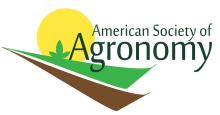Resource information
The sunflower (Helianthus annus L.)-soybean [Glycine max (L.) Merr.] intercrop has emerged as an option that increases land productivity in the southern Pampas of Argentina, compared with sole crops, because of complementary use of resources between species. A common management practice for this intercrop consists of delay soybean sowing, although delayed planting reduces the capacity of soybean to capture resources. Simultaneous sowing could improve total intercrop productivity because of an increase in soybean grain yield with no or little detrimental effects on sunflower grain yield. The objectives of this study were to analyze the response of the sunflower-soybean intercrop and of their component species under different sowing management (i.e., relay or simultaneous sowing) and water availability conditions. Three experiments were conducted at Balcarce, Argentina. Four cropping systems were evaluated: (i) sunflower-soybean intercrop with simultaneous sowing management (I00), (ii) sunflower-soybean intercrop with 30 d of delay between sunflower and soybean sowing (I30), (iii) sunflower sole crop (SUN), and (iv) soybean sole crop (SOY). Sunflower-soybean intercrop grain yield tend to be higher than that for sole crops of the component species. This yield advantage for intercrop increased with water availability and was associated with an increase in intercropped soybean productivity. Intercrop sowing management had no effect on total intercrop grain yield. However, simultaneous sowing increased soybean contribution to intercrop yield. Finally, our results indicate that agronomic practices that promote intercropped soybean performance increase intercrop productivity relative to the sole crops of their component species.



